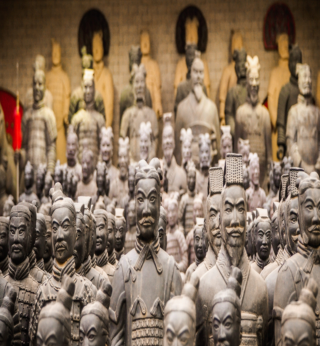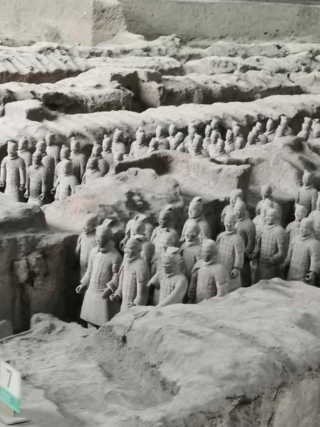Terracotta Army.. A Chinese Marvel of Clay

By pure chance, in early 1974, while digging a well in a suburb of Xi'an, the ancient capital of China, a group of farmers stumbled upon the tip of what would later become one of China's archaeological wonders, revealing an important part of China's history and the beliefs and myths that accompanied its emperors, transforming it into one of the most active and attractive tourist destinations.
In 246 BC, the first emperor, Qin Shi Huang (259-210 BC), ordered the construction of a great clay army, replicating his real army, to accompany him on his eternal journey after death. Thousands of skilled artists began building that army, which numbered more than seven thousand fighters and knights in full military gear, accompanied by horses and chariots.
The Emperor ordered that the statues should bear real features in terms of heights, sizes, ranks of soldiers and their personal features, in which no two statues were alike.

According to Chinese historian Siam Qian, who is described as the court historian of the Han Dynasty, the young emperor Qin Shi Huang ordered the construction of the mausoleum shortly after he took the throne and more than 700,000 workers were involved in the massive project.
The Chinese government has transformed the emperor's tomb and the three pits surrounding it, which include the Terracotta Army, which in Chinese means "funeral statues of knights and horses," into a museum that receives millions of visitors every year, and is visited by leaders, heads of state, and art and movie stars when they visit China.
Kong Xiangdong, deputy director of the Terracotta Army Museum in Xi’an, told that the statues, which were discovered in March 1974, were later turned into a museum in October 1979, which includes the tomb of the first emperor in Chinese history.

According to Dong, the cemetery contains three main sites or pits that were discovered in succession and bear different numbers according to the first, second and third exploration dates.
These sites contain about seven thousand statues of Emperor Qin Shi Huang's army that accompanied him on his eternal journey after death, as this army was buried with the emperor.
The deputy director of the museum told that this discovery is of particular importance in view of...
The great and pivotal role played by Emperor Qin Shi Huang in ancient Chinese history, as he unified all the states in China, and the administrative system he built has influenced Chinese history to this day.
digging and seven thousand statues

“The site consists of three very large pits, with the first pit covering more than fourteen thousand square meters, and the second pit covering approximately six thousand square meters. Each pit contains thousands of large statues that are similar to the real sizes of the emperor’s army at that time. The statues are 1.8 meters high on average. The workers made these statues based on pictures of real people whose faces and real features were photographed,” Dong told “Special methods were used to make these statues, as they were made by hand and not in ready-made molds. Each statue is different from the other. These statues were made according to the shapes, sizes, and ranks of the ancient soldiers, knights, and officers. These soldiers were from different parts of the empire, which means that their features differed greatly,” Dong added.
“At the beginning of exploring these statues, we found that there were colors on the bodies of these statues, but due to natural disasters and after they were vandalized by people, only a few colored statues remained. How to preserve the colors on these statues was a big problem we faced, but after tireless efforts that lasted for more than ten years, we were able to protect the colors on the statues in the laboratories, and I believe that visitors to this museum will perhaps touch the effects of restoration on these statues better soon,” the deputy director of the museum added.
The Terracotta armies carried bronze weapons that were preserved in good condition, and this has puzzled scholars who have put forward many hypotheses as to the reasons for this. Some say that the Chinese relied on highly appreciated technology in painting these weapons, and others say that the soil surrounding the weapons could be responsible for preserving them in good condition.

Although the total number of statues in these pits is large, approaching seven thousand statues, the deputy director of the museum points out that new sites and other side tombs are being found from time to time, in addition to the three main tombs, as the area of the imperial tomb, according to Dong, exceeds 56.25 square kilometers.
“So far, we have found more than 10 archaeological sites of ancient buildings, and we have also found more than 600 side tombs of this main cemetery, which has been listed as a UNESCO World Heritage Site, due to its great importance in shedding light on special and hidden features of ancient Chinese history and the political system at that time, and it also reflects the progress and development of arts in ancient China, which was expressed by the quality of the inscriptions and arts in that important era that witnessed the unification of China,” the deputy director of the museum added.
“China has exhibited some of the clay army statues discovered in the tomb in about 30 countries, and two mobile tours of some of the museum’s collections have been organized inside China,” Dong continues.

He pointed out that there is an annual program to display some of the museum's collections outside China, at a rate of three to five countries. The main tomb containing the remains of Emperor Qin Shi Huang is located 1.5 kilometers from the three sites containing his Terracotta Army.
According to the deputy director of the Imperial Tomb Museum, every emperor in China would begin building his own tomb immediately after ascending the throne, which usually took a long time, perhaps years. This tradition goes back to beliefs based on the idea of resurrection and eternal life, in which the emperor begins a new phase in which he must enjoy the same advantages he enjoyed in this life, in addition to the prevailing belief at the time that the emperor must be accompanied by his guards or sometimes his army to fight his enemies who would pursue him in the afterlife after death to take revenge on him.
Dong points out that the terracotta army of Emperor Qin Shi Huang is not the first in Chinese civilization, as there are many Chinese emperors who buried similar statues in their tombs, but what distinguishes this tomb is the unprecedented number of statues and equipment, including musical instruments and other equipment, as the tomb includes more than 130 chariots pulled by more than 500 horses, in addition to another 150 horses designated for knights.

Dong points out that many details of social and political life can be learned from the writings on some statues and weapons.
The deputy director of the museum does not rule out the possibility of a mutual influence between Chinese civilization and other civilizations that have similar beliefs regarding burial rituals and eternal life, including ancient Egyptian civilization.
“Throughout its history, China has had cultural and human connections with Eastern civilizations, such as the Pharaonic civilization, and some beliefs may have been influenced by each other, including the ancient customs in China that required burying kings with all their belongings, in the belief in the afterlife,” Dong says.
“But in the end, there is no conclusive evidence yet that there was a direct relationship between the tombs of China and Egypt,” he adds.
Natural and human challenges

Dong points out the global interest enjoyed by the museum, which has received more than 100 million visitors from all over the world since its opening. In 2018, it received more than 8.5 million visitors, a significant increase in the number of visitors, which doubles the size of the challenges, according to the museum’s deputy director.
He told, “Those in charge of the museum are now facing many difficulties and challenges in protecting the statues, in addition to the increasing difficulty in receiving this increasing number of visitors.”
“The most difficult thing for us is how to protect the clay artifacts, and also some of the colored statues, given that there are many reasons that might damage these statues, including the increase in the number of visitors, which is one of these reasons, which prompted us at this stage to think about reducing the number of visitors, and also protecting the artifacts and increasing their safety measures through the use of modern technology,” he added.
He told Al Arab, “We also worked to slow down the pace of extracting these statues, from digging and adhering to the principle of partially extracting the statues and restoring them, and then we explore another statue.”
“We also recolor each statue so that it lasts longer. We also control the temperature and humidity in the exhibition halls because Xi’an is located in northwest China, and the weather there is always dry, in addition to the large fluctuations in temperature. For this reason, we built the new buildings using some special devices and equipment to control the temperature and humidity in a stable manner. All these measures increase the protection rate of these historical monuments,” he added.
Source : websites

